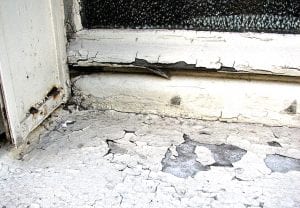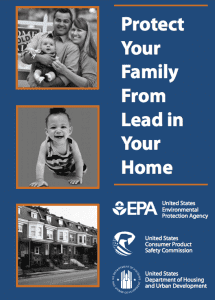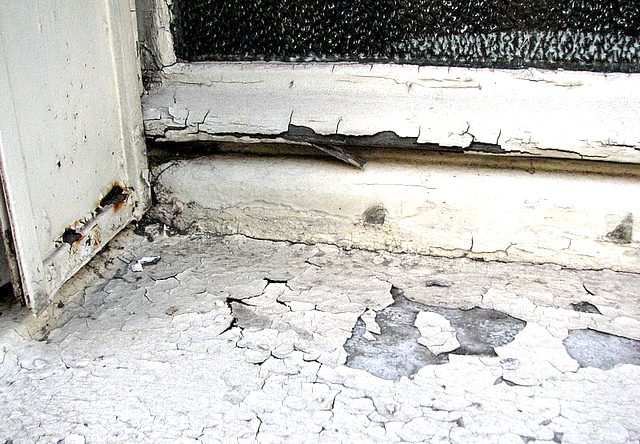
Photo by Todd Mecklem via flickr, CC BY-NC-ND 2.0
What do a rock star and a refugee living in Maine have in common? They both have sons who were poisoned by lead dust.
While the two cases are different, they represent the primary causes of lead poisoning in children—older home renovations and low-income subsidized rental housing. Both were easily preventable: one by market incentives and the other by regulation.
I don’t know Jon Fishman, drummer of the band Phish, whose son was exposed to lead dust. The Fishman family doesn’t need federal funds to address the lead paint that poisoned their son, but Fishman has spoken publicly about his family’s experience with lead dust in their 200-year-old Maine farmhouse. He told The Huffington Post in 2015 that he suspected the lead dust was created when the home’s floors were stripped during a renovation and the house was cleaned without a HEPA filter. Fishman’s wife runs an organic farm, and it’s ironic that while the family was limiting their exposure to chemicals in food, they were unknowingly exposed to a neurotoxin in their own home.
I do, however, know the immigrant woman whose young son who was exposed to lead dust in the two-bedroom apartment they rent, and who now has a developmental disability and other health problems. The boy lives with his mother, who has no income, no car, and limited English skills, and five siblings. He also has pica, a disorder that compels him to eat non-food substances. I met them because after his poisoning, their landlord was legally obligated to abate the lead hazards in the more than 100-year-old home. She could not afford the lead abatement and applied for Housing & Urban Development (HUD)-funded assistance from the Healthy Homes & Lead Hazard Control program I managed in Maine and that the municipal government in Portland administers federal funds to assist.
Every painted surface in the apartment had child-sized teeth marks. Much of the paint had been chewed down to bare wood. Thankfully, the majority of the paint was lead-free or the poisoning could have been life threatening.
You can’t see lead dust, but housing authorities and local codes, except in a handful of cities, don’t require full lead inspections. Instead, multiple officials approved funding for the family’s home based on various visual inspections, such as the Housing Quality Inspection (HQS) performed by the local housing authority prior to approving a property for Section 8 assistance, despite the obvious risk factors. This program is also funded by HUD.
How Could It Have Happened?
Lead paint was banned for use in residential homes in 1978, so how did these children both end up poisoned in 2017 in such different circumstances? We still have lead paint in an estimated 37.1 million homes in America. Regular wear and tear of windows and doors creates lead dust, and many repairs and renovations disturb old layers of paint. Lead dust is easily transferred to the bloodstream by hand to mouth contact.
In 2017, the Health Impact Project, a collaboration of the Robert Wood Johnson Foundation and The Pew Charitable Trusts released an assessment of the health costs associated with childhood lead exposure. A team of experts completed a cost-benefit analysis for lead remediation in the homes of all U.S. children born in 2018, and their modeling showed that the potential benefit of preventing lead poisoning for that cohort could reach $84 billion.
There is no EPA office or staff in the state of Maine to enforce compliance with lead-safe practices. In its report, the Health Impact Project calculated that full enforcement of lead-safe renovation rules would protect about 211,000 children born in the U.S. in 2018 and provide future benefits of $4.5 billion, or about $3.10 per dollar spent. As long as the EPA doesn’t have the resources to consistently and sufficiently enforce the law, the existing regulations will never compete with the home improvement and renovation market to create awareness around the need for trained and licensed contractors to keep children safe from lead paint.

In 2015, the do-it-yourself home improvement market in North America turned over more than $320 billion. The Lead Risk Reduction program, which certified contractors who worked in buildings that may contain lead, was eliminated in the EPA’s 2018 budget and the department’s enforcement capability is chronically underfunded.
The process for rented units is different. In the second case of childhood lead poisoning, the immigrant mother and her six children lived in a two-bedroom rent-subsidized apartment. This should require a housing inspection by the funder, in addition to routine building safety inspections under municipal code, but standards are often inconsistent. At minimum, a housing caseworker or child social worker should have performed a visual inspection before approving payment to the building owner.
The visual risk factors (old building, peeling paint, original windows, and children under six) are clear, but the presence of lead paint can only be confirmed through state-certified methods, which were never done. A housing authority subsequently inspected the building, as there are other tenants who use a federally funded Section 8 voucher to pay for rent. I was the last in a line of public officials, housing inspectors, and social workers that walked through that building.
Though it may seem unacceptable that any type of housing inspection would not assess the health implication of placing a vulnerable child in a pre-1978 building—in a town with a high rate of childhood lead poisoning—this happens over and over. There were caseworkers advocating for the health, education, and social needs of the children, and who were communicating on the mother’s behalf, so there was ample opportunity for collaboration between them, housing officials, and the property owner, and yet it appears none of these parties identified or prioritized the obvious risk of lead poisoning.
A complete lead inspection of this property would cost over $1,200 in Maine but a housing official, case worker, nurse or parent can undertake a free lead dust wipe test (through a Maine CDC program) or insist the owner hire a certified professional to perform a basic lead screening with an XRF (X-ray fluorescence) hand-held device.
We have known for decades how poisonous lead is, and that children under age six are at particular risk for poisoning. The statistics are scary: 535,000 children between the ages of 1 and 5 are diagnosed with blood lead levels of 5 micrograms per deciliter or higher each year, which is considered unsafe. More than 37 million homes in the U.S. contain lead paint and 23.2 million contain obvious lead hazards, such as peeling and chipping paint on old windows. Children who are poisoned are estimated to lose two IQ points for each 10 micrograms per deciliter rise and the first 1 to 10 micrograms per deciliter is associated with a loss of six IQ points. Yet, policies and budgets continue to target children only after they are poisoned, essentially using American children as canaries in coal mines.
The Cost of Housing
The societal and financial costs associated with lead poisoning are astronomical. Eliminating lead from pipes, houses, and schools would save the federal government about $19 billion and state governments about $10 billion for children born in 2018 alone, according to the Health Impact Project report.
We should no longer determine housing as “affordable” based solely on the household’s gross income as compared to the direct costs. The cost of housing is not simply the mortgage, rent, and utilities, but the individual and community health, education, and social costs associated with low-quality, unstable, and unhealthy housing. All too often buyers and renters must choose between “affordable” and their health because of current local, state, and federal housing regulations and affordable housing incentives.
The federal government spent $190 billion in 2015 to assist Americans to rent or buy homes. This is a missed opportunity to increase the health of our low-income housing stock. Approximately 3.6 million homes with lead paint hazards house young children, and about 1.1 million of these households are low income. The Centers for Disease Control collects data on elevated blood lead levels for public health reasons, HUD collects data on residents and properties that receive federal funding to address lead hazards, and housing authorities collect data on properties where tenants receive Housing Choice Vouchers, but there is no testing program or requirement for universal lead hazard in paint and soil in properties rented or purchased with federal dollars until after a child is poisoned.
HUD has a complex set of rules determining when public housing or Housing Choice Voucher programs require that a landlord complete a lead inspection and lead abatement, but a 2017 HUD audit of these housing programs found HUD lacked oversight of its own lead-paint inspection and remediation programs. This organization is responsible for driving the prevention of childhood lead-poisoning prevention in affordable housing, and its failure to provide oversight illustrates its lax approach to regulating the low-income rental sector.
Addressing Lead Hazards – Putting Children’s Safety First
Affordable rental markets around the country, like southern Maine, are under pressure, and market demand tilts the balance of power firmly toward property owners and landlords. Families are desperate for affordable rental properties and so are not in a position to demand lead inspections. Housing services working with desperate families on a local level must often choose between unsuitable apartments or homeless services.
The argument put forward by the real estate industry is that by requiring maintenance and inspections, the price of affordable housing will be driven higher than it already is. The city of Rochester passed a rental housing lead law in 2005 aimed at controlling lead hazards before children are poisoned. Landlords predicted that compliance with the law would increase costs and therefore increase rental prices, causing abandonment of affordable rental properties. Research conducted after four full years of implementation surveyed duplex owners and found 34 percent had spent $0 on compliance, 37 percent spent less than $1,000, and 30 percent spent over $1,000 on compliance repairs. Focus groups and property value analysis found no disruption of property prices or the rental market as a result of the lead law.
Rochester’s lead law did succeed in lowering lead poisoning levels and is an example of the type of solution needed: local, state, and federal housing policy should connect housing and health before children present physical and mental health problems related to unhealthy and unstable housing.
We know the impact of lead and other housing health hazards, now it’s time to integrate safe housing into health treatments. For example, previous research with housing-insecure families utilizing Boston Medical Center (BMC) who had one child between the ages of 0 to 4 were classified as high health-care utilizers (defined as three or greater emergency room visits in one year). In response, they launched Housing Prescriptions as Health Care, which aims to study the effects of housing and case management supports on child health and utilization of health care. This kind of program is a great opportunity to push for better testing for and resolution of lead hazards.
Other coalitions of health care providers have developed supported housing models using health care dollars to build affordable and healthy housing units and finance case management services. These initiatives should provide important learning for addressing the intersection of affordable, inadequate, and unhealthy housing that is making so many children sick. But this approach cannot work without the affordable housing development industry and the associated federal incentives and programs reframing the definition of affordable to include all the health costs proven to be associated with poor housing.
Parents, like the Fishmans, who can afford to negotiate, should insist on lead inspection reports as part of the house-purchase process. We have incorporated this into regulation when it comes to radon, and lead paint poses a much greater health risk for our children. Low-income renters and buyers often don’t have negotiating power, so that is where local governments need to reform their housing and building codes to address potential health hazards through code enforcement and permitting.
The children of rock stars and refugees alike should be safe from heavy metal poisoning in their homes, and we cannot wait for the federal government to protect them.





Truth is the hazardous lead in these homes can effectively be sealed and treated protecting children and their family. Ecobondlbp.com
Excellent article. Although encapsulants don’t work on friction areas such as window jambs, Paul. There are a variety of other lower cost interim controls that can be used as well as replacement of components such as the 100+ year old window sashes that are usually in terrible condition. But trying to get most landlords to be proactive to prevent lead poisoning is almost impossible unless there is a law and enforcement as in Rochester.
Even after landlords have been sued, some are still reluctant to use programs that can assist them in the renovation and repairs.
Thanks for the reminder of how dangerous lead is for children, especially those under six years old. My wife and I are currently looking for a new house to settle down in. We’ll be sure to have possible options tested for lead before agreeing to anything.